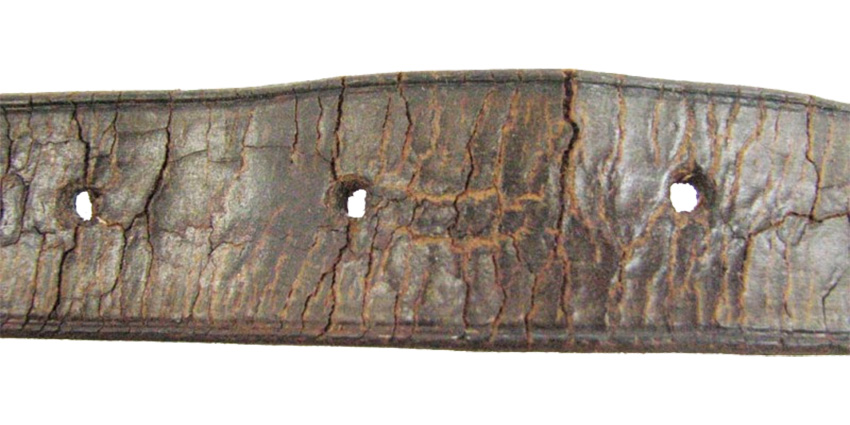One commonly asked question we often get is whether or not it’s safe to get your leather watch band wet. Should you remove your leather watch strap before a swim or a shower? That is the question we hope to answer for you today.
In short, no—you do not want to get your leather watch strap wet or fully submerged in water. Water will slowly wash away the oils and protective coating that keep the leather supple, causing it to become dry and cracked. Additionally, water that is absorbed into the leather can lead to mold and mildew, resulting in further damage to your strap.

Image: Leather that has become dried and cracked
Depending on the quality of the leather, most straps can withstand a few drops of water here and there. If the leather is finished in a vintage or distressed style, then you want to be more careful than you would with a strap that has a smooth, well-coated finish. Also, bear in mind what material your band is lined with, as suede will be more sensitive to damage from wetness than smooth leather. To keep your leather watch strap dry, we suggest simply removing it before swimming, showering, rigorous hand washing or exercise. If you prefer to keep your watch on for these activities, you should opt for a durable rubber or silicone strap instead.







Comments
That’s okey 🙂
I once wore a leather strap swimming in the Caribbean. Everything seemed fine until I woke up the next morning with my watch and several pieces of disintegrated watchband lying beside me in bed.
Just today I was looking at watches in a local store and on high end Tudor had a rubber strap that looked and felt like suede. Never seen it before and it was on a dive watch.
There are some leather watch bands that are suitable for swimming but not for hours on end. They are treated with water repellent chemicals and the inner liner is not paper or cardboard but a breathable layer of leather.
My oldest leather strap is from a 1915 trench watch. It was obviously a British officer’s watch. Its strap was, like his other leather kit, revolver holster, compass case and last but not least the world famous “Sam Browne” belt. Also to these would have been attached an ammunition pouch, telescope tube and compass case – all these items were made from leather.
A British officer’s batman would have used saddle soap to treat all these items. Leather will last for hundreds of years if looked after correctly. I also have in my watch strap collection a very early Army & Navy Stores (London) leather deployent strap. This is still in very good condition for its 80+ years.
Hunting saddlesare also made from leather would have been cleaned reularly with saddle soap. Early examples from the 19th century regularly appear at auction. Many are still in good condition.
One of a leather strap’s greatest enemy is human sweat. This contains mainly water with small amounts of water, urea, salts and sugar. The ammonia will, in time, degrade cotton stitching which is a very good reason for owning a good pin removing tool and swiching to a manmade fibre strap for the summer months!
One of my oldest straps is from a 1915 trench watch. Obviously a British officer’s watch, its strap was, like his other leather kit, revolver holster, compass case and last but not least the world famous “Sam Browne” belt, all made from leather. Also, to the “Sam Browne”, would have been attached an ammunition pouch, telescope tube and compass case – all these items being made from leather as well.
A British officer’s batman would have used saddle soap to treat all these items. Leather will last for hundreds of years if looked after correctly. I also have in my watch strap collection a very early Army & Navy Stores (London) leather deployent strap. This is still in very good condition for its 80+ years.
Hunting saddles are also made from leather and would have been cleaned regularly with saddle soap. Early examples from the 19th century regularly appear at auction. Many are still in very good condition.
One of a leather strap’s greatest enemy is human sweat. This contains mainly water with small amounts of ammonia, urea, salts and sugar. The ammonia will, in time, degrade cotton stitching which is a very good reason for owning a good pin removing tool and switching to a manmade fibre strap for the summer months!
Best treatment for leather straps is Rawlings ( the baseball glove makers) Glovolium with lanolin or their glove conditioner. MLB players use this or Nokona’s similar products on their $500+ baseball gloves. I use it on all my leather straps except suede of course.
Leather can be worn in wet conditions, but it’s best removed for showering, swimming, ect. You can coat your leather bands in Snoseal if you plan on working or spending a lot of time in rain occasionally swimming and showering. Best is to get a rubber, FKM, solicone, sailcloth strap ect.
This is your first line of defense
Apply Protection & Conditioning
Use Wax-Based Protectants: a good beeswax cream or leather wax creates a protective barrier on the surface that actively repels water and sweat. But be aware this may slightly darken the leather. Apply regular onditioning: every few months, apply a quality leather conditioner (like a specialized leather balm) this will replenishes the natural oils lost to moisture and drying, which is crucial for preventing the leather from becoming brittle, stiff, and cracked over time.